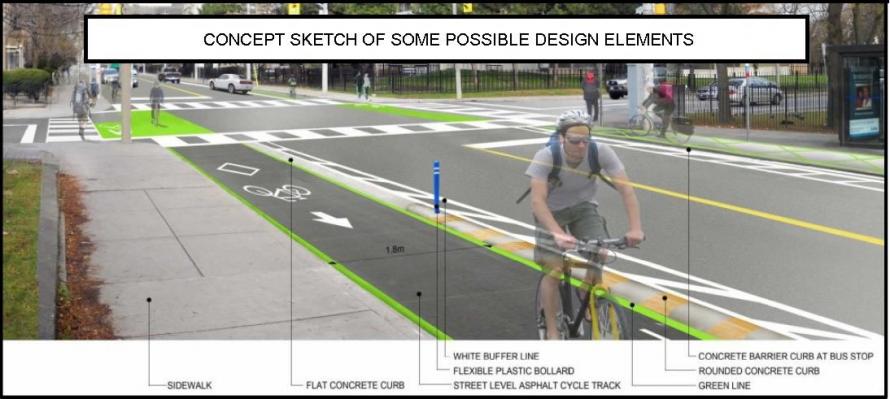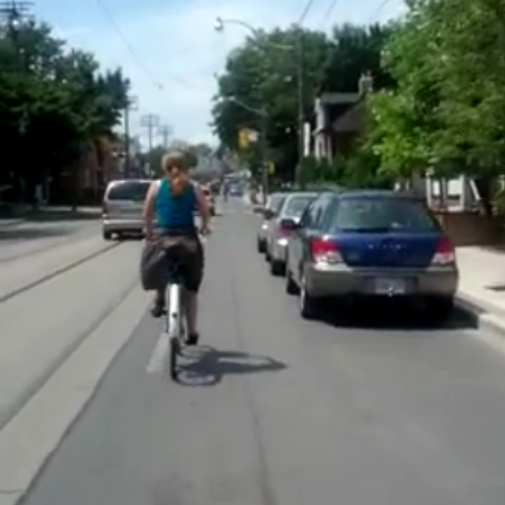The second open house for the Wellesley-Hoskin cycle tracks (aka separated bike lanes) is next Tuesday, September 11 from 4:30 pm to 7:30 pm at Seeley Hall - Trinity College, 6 Hoskin Avenue (on the U of T campus, north side of the street).
It's important that we have a good showing from the public. It's clear from surveys that Torontonians are much more likely to consider cycling if they have some separation from car traffic. Wellesley to Harbord is one of the only feasible routes through the core (I enumerated the reasons previously). Still, we have to overcome the digging-in of heels by Councillor Wong-Tam, who seems to want to indefinitely delay the installation but has provided zero alternatives for safe cycling routes in her ward despite claiming to be a cycling-friendly councillor. Councillors Vaughan and McConnell are both supportive of the cycle track. Please consider thanking Vaughan and McConnell (and Councillor Minnan-Wong if he attends) for supporting the separation; while at the same time letting Councillor Wong-Tam that you support cycle tracks on Wellesley (talking points below).
The second open house will explore options for more detailed designs, based on input from the first open house. From the input received so far, staff have identified some key trends:
- The majority of respondents are positive about improvements to the bicycle lanes to increase safety for cyclists.
- Some residents are concerned about the potential negative motor vehicle traffic impacts which may result from the removal of all left turn lanes from Wellesley St.
- So far, few concerns about the removal of on-street parking have been expressed; staff continue to investigate loading and delivery concerns.
- Park users and cyclists would prefer a dedicated on-street cycling facility around Queens Park, to avoid conflicts which may result from heavy cycling traffic mixing with pedestrians using the Queens Park Multi-Use Path.
It's encouraging to see that the proposal is not raising a lot of opposition from residents.
Update: Talking points for the Open House
I'm providing some handy responses to some of the criticisms brought up by Councillor Wong-Tam. You could consider using them if they are brought up at the open house by her or others.
1. The proposal is rushed.
It's been a slow process, hardly rushed. City Council approved it July of 2011. It has been now delayed to 2013 when installation might begin. This is the second open house. Toronto is only now installing its first cycle track. New York City managed to install many more miles at a faster pace.
Far from being rushed Toronto is far behind other major cities in North America including New York, Vancouver, Montreal, San Francisco, Ottawa, Portland, all of which have started separating on-road bicycle lanes from traffic.
2. If we don’t get it right we might not get a second chance.
Toronto transportation staff are professional and competent and have studied how other cities have implemented cycle tracks. The plans they've shown so far show how they've learned from European and American cities.
3. There has been a lack of consultation.
The Wellesley-Hoskin cycle tracks have been raised at two Public Works and Infrastructure Committee (PWIC) meetings (June 2011, May 2012). The first public open house was in June and this is the second.
A number of residents associations have discussed and support the cycle tracks.
The Bay Cloverhill Community Association supports the separated lanes (so long as it goes around Queen's Park instead of on the paths). The ABC Residents Association (Yorkville ) and the Moore Park Residents Association, both Ward 27 residents groups, have both written to Councillor Wong Tam requesting her support of the cycle tracks. The Church Wellesley Neighbourhood Associaton discussed and provisionally supported the cycle tracks.
4. Complete Streets need to be implemented.
"Complete Streets" is a vague term. Still, the changes to Wellesley are easily implemented and removed and involve temporary curbs installed in the road allowance. Changes can still be made to the road later on.
If by "complete streets" it means no separated bike lanes then we don't support this interpretation. Wellesley is the only street in the area with no streetcar tracks or significant on-street parking or retail.
5. Cycle tracks take space from pedestrians.
Cycle tracks reduce pedestrian injuries on streets where they have been installed. They provide a buffer for pedestrians. Pedestrian safety should be the priority, not just an analysis of the physical amount of space allocated to different road users.
6. Left hand turns need to be maintained.
Make a point of saying that you want as few left turns as possible.
All road users are safer - pedestrians, cyclists and motorists - when there are fewer left turns. There are fewer points of potential conflict. Transit will move faster. In downtown Toronto cyclists and pedestrians should have priority not automobiles with single occupants. There are already a number of intersections in downtown that prohibit left turns, let's make it safer here as well.
7. Loss of street vehicle parking.
There is almost on street metered parking on Wellesley. There are lots of commercial parking garages and on street pay parking in the vicinity, with more being installed.
We need to move away from prioritizing motorist convenience over cyclist safety.
8. Reduced access for retail businesses and hurting redevelopment of condos on Wellesley.
Obviously separated bicycle lanes make access more difficult to businesses and properties on Wellesley. Sidewalks for pedestrians do the same thing but no one questions that outcome. We have to have some streets where cycling trumps other modes of transportation. The car trumps everything everywhere else.


